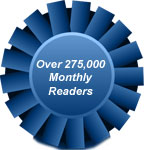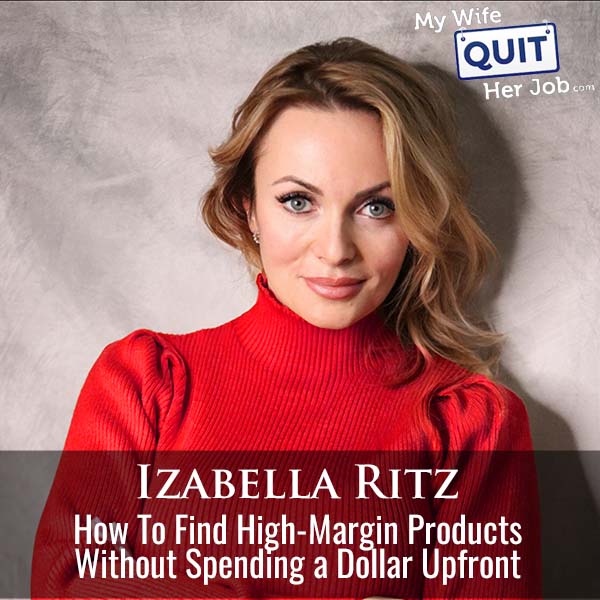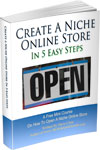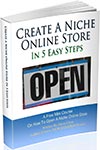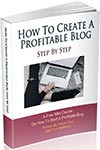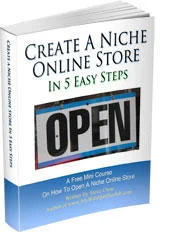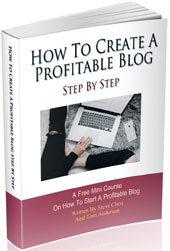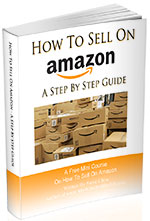Podcast: Download (Duration: 44:55 — 51.7MB)
In this episode, I sit down with Izabella Ritz, founder of Ritz Momentum and one of the sharpest minds in eCommerce, to break down exactly how to find high-margin, profitable products that actually sell.
Get My Free Mini Course On How To Start A Successful Ecommerce Store
If you are interested in starting an ecommerce business, I put together a comprehensive package of resources that will help you launch your own online store from complete scratch. Be sure to grab it before you leave!
What You’ll Learn
- How to find high-margin products to sell without any upfront cash
- Simple tricks with AI to discover profitable items fast
- How validate that your product will sell without buying inventory upfront
Sponsors
SellersSummit.com – The Sellers Summit is the ecommerce conference that I’ve run for the past 8 years. It’s small and intimate and you’ll learn a ton! Click Here To Grab The Recordings.
The Family First Entrepreneur – Purchase my Wall Street Journal Bestselling book and receive $690 in free bonuses! Click here to redeem the bonuses
Transcript
Welcome back to the podcast, the show where I cover all of the latest strategies and current events related to e-commerce and online business. In this episode, I sit down with Isabella Ritz, founder of Ritz Momentum and one of the sharpest minds in e-commerce to break down exactly how to find high margin profitable products that actually sell. But before we begin, I wanted to let you know that the recordings for Seller Summit 2025 are now available over at sellersummit.com. The Seller Summit
00:29
is the conference that I hold every year that specifically targets e-commerce entrepreneurs selling physical products online. The talks this year were incredible with tons of actionable advice and behind the scenes insights from every speaker. If you want to catch the recordings, head over to sellersummit.com. Now onto the show.
00:54
Welcome to the My Wife Quoter Job podcast. Today I am thrilled to have Isabella Ritz on the show. Now Isabella is the founder of Ritz Momentum, where she helps Amazon sellers find and validate profitable products to sell. She’s very well known in the Amazon community and she just spoke at my annual e-commerce conference called the Seller Summit, where attendees really raved about her talk. So in this episode, we are going to break down Isabella’s strategies on how to find and validate profitable products to sell online.
01:23
without spending any money upfront on inventory. And with that, welcome to the show Isabella, how are you doing today? Thank you very much. Thank you for having me at the event. I had so much fun. And when I saw that, I believe Tony put me first right after your speech to talk, I’m like, oh my God, that’s a lot of pressure, but I’m glad everyone had fun. And I am very happy to share today everything you want to know. That’s great.
01:52
We put you against Tony, I think. And I think that might have worked to Tony’s disadvantage because, you know, a lot of people did attend a 10 year session. So with rave reviews. Great. I’m glad that I made other people happy, but I really wanted to be at her talk because I’m like, well, last time when I was at your event, her talk was the most impressive for me. And she was talking about all these crazy funnels that
02:22
pretty much every single business, not just Amazon sellers supposed to do like if you’re not doing funnels, follow ups, sending out the emails to those that clicked and didn’t approach you like you’re losing you’re losing so much money on the table. Oh, definitely 30 % of my businesses email. So. So Isabella, many of my listeners probably do not know who you are. So how did you get into e commerce? And actually, are you currently selling on Amazon today?
02:52
I do sell on Amazon today and I want to say it’s very contagious. Like the moment you stop selling, it’s, it feels like you’re missing something. And I know it because we exited three brands in 2021. And then mine, and I will get back to the story, how I started and the brand we’re selling right now, it’s a Japanese brand. We started because it was out of principle. We.
03:18
We had one client, he came to the agency and he said, find the product for me to sell. We did find the product that was extremely advantageous and he didn’t have a huge budget. He had like probably like 20 to 25,000 to launch his brand on Amazon. And then he said, you guys found a shit show. It’s not the product that I will be able to sell. And this product doesn’t have any opportunities. And I got so pissed. And I said, whatever, I will launch this product myself.
03:48
And I did and it became bestseller and would you have time like during Q4 this product is making like 60 to $80,000 a month. And then it’s like, it does have consistent sales because it’s a niche niche product. But at the same time, like, okay, so now we have to create a brand around this product. So we created a brand around this product. This it’s mid six figure right now. So we’re
04:14
I don’t know if I want to grow it to eight figures or something, but this probably will be like low one, low seven figure brand. But this is how this is to the point that selling on Amazon is contagious. And this is something that you just want to continue doing it. I got into the Amazon space back in 2015 when I moved from Russia to live in United States. And I just
04:43
I was already serial entrepreneur, so I knew I’m going to do some type of the business, but I didn’t have language. I didn’t know culture. I didn’t know anything. And I was just Googling like, what should I do in United States? What kind of business should I do in United States? And everybody was talking about Amazon. And if you will look at the space right now, a lot of sellers started back in 2015, 2016. just, it was a boom. And I was probably one of these people that was in the
05:12
wave of this 2015. And I did start and I think I was super lucky because a lot of products I was launching, they’ve been just very intuitive, no validation, generic, didn’t even slap my log on it. It was just let me launch a product. first product was… Back in the day, it was like that, right? Just throw it up. Yeah. Yeah. And I launched Silicon Wineglass and I made…
05:39
$14,000 on top of my investment month one. I still don’t know how it happened, but it happened. I was very happy about it. And this is where I realized, Amazon works. guess I just will stick with this. And I just continued with a lot of mistakes after then this product became unavailable for me to sell because someone patented. I didn’t know at the moment that patents are territorial.
06:05
And this patent was filed in UK, not in United States, but you live, learn. If we would know better, we would do better. I’m curious, that client who got angry, did you show them the product that they could have launched? Oh, no, I didn’t. Because I was proven to myself. I’m like, no, I’m good. But if you would ever reach out, I will make sure to punch him in the face by seeing. I know it seriously. So the last we mentioned that I actually started, I think, in
06:35
2016 or no, 2014. I can’t remember, around the same time you did. It was a lot easier back then. But just in the last couple years, Amazon’s been squeezing both sellers and buyers more than ever before. So I want your opinion real quick before we get started. What do you think about selling on Amazon specifically today and how have your strategies adapted as a result? Because obviously you can’t just buy something unbranded and throw it up anymore. No, you definitely cannot. Some people still do and some people still
07:04
doing it successfully. I think it’s just the lack of first time mover. Like I will try first time and let’s see how it works. For some people it still works, but I don’t see much success in it. I never believed in cheap products. It’s just the nature of my personality. I never believed in low ticket prices. Even this, my silicone wine glass, was selling at $39.99 back in the days and it was set up for, and I was, my cost of goods was
07:34
five bucks, I believe, or something like this. So I stick with the theory that we have to sell high ticket products, products that actually have margin. And if you’re based on consumers’ demand, consumers’ avatar, shoppers’ experience, and you develop the product the way your buyers are ready to pay higher price,
08:02
you will be successful. like, don’t go out after the BSRs and like all this craziness, just going after margins. And I do agree Amazon is squeezing everybody. And I just believe that we have to be not in the crowd of people that are talking and squealing, but we have to be on the side where we can win. So
08:26
if it’s an opportunity for us to win, how we can have it as an opportunity. Where is the opportunity here where everybody suffers? So you’re just finding it and you’re bringing it to the market. So how do you define high end? Like, can you just throw some numbers? Like, what do you consider a high ticket item? So let’s just go with another example. We did have a client coming to us to sell blades. most of the blade blades is kind of plate.
08:56
but at the same time it’s in between plate and the bowl and it does have a keyword, blades. So it’s kind of deep plate. The average price for this product, I believe is $39. If I not mixing out, we launched his product at $89. And it happened because we’ve been learning customer demand.
09:25
and what are they ready to pay for? So people didn’t like that this product is breakable, is not dishwasher safe, and like a lot of other features and benefits that other sellers were not able to provide. So we really developed the product the way where customer will be happy to pay higher price because this product has an opportunity. And the reason this product has an opportunity, again, we find out about it because of the customer feedback.
09:55
This product has been purchased primarily as a gift. So when we’re given a gift, we want to look good. If I am given the gift, that means I want something that is more expensive and at the same time people will use for a long time. So, and when you do this discovery of the product, this is where you’re able to find out if people are willing to pay higher price. So if I’m selling vitamin C,
10:23
I have doubt someone would want to pay $20 for product that you can buy at $6. There’s just no opportunity for this. But there are a lot of products where it’s a huge opportunity to sell at the higher price because of different reasons people are purchasing this product. So in your plate example, though, I am kind of curious, and you don’t have to reveal the actual plate, but to charge two and a half times more than the market, it sounds like it was a completely different
10:53
I’m just curious. didn’t see this guy continue selling. I don’t know why, but when he launched it was a hundred thousand dollars launch. Wow. It was huge. It was like amazing. And but like just I’m just trying to get an idea though. Was it did it look completely different than all the listings out there? It
11:22
didn’t it didn’t look completely different. I think my husband actually just heard me and I think I was gonna go get it. I will not be surprised if he’ll bring this blade and I actually hear his I think he’s taking this blade. Okay. It did look different at the time. I didn’t analyze this listing for this market for a while but we made it wider. We made it a little bit deeper and we literally went through the supplier and created the sample with completely different design.
11:49
And we didn’t just test the design against each other. We tested pricing structure as well. So would you purchase this product that looked like this as $39 or will you purchase this product that, oh, I actually, yeah, I’m about to show you guys. It’s right here. So, will you purchase this product that is like handmade and hand painted on a different way?
12:18
That’s pretty cool. Thank you. Yeah, that’s great. I wish my wife was here to help me out with these podcasts too. Yeah. Well, you never know. thought he’s in his headphones, but he wasn’t. But yeah, this is like how we really structured the product. And this one, we use it for like over two years. Dishwasher safe, never broke one and you know, sometimes things break. So you just develop the product the way your customer is asking for. And then you sell it at the price.
12:48
I’m glad you brought the plate up as an example, because that is an item that I would think would be saturated. So what I want to do next is talk about your process for finding a good product. And I know you rely heavily on AI these days. So just walk me through your process. I would love to hear it. Yeah, this AI process. Because of the AI process, everything changes literally every day. So if in the past I was just
13:18
Not even in the past, a year ago, I was taking the data sets from Smart Scout and I was uploading these data sets into GPT, which was also with the HubAVI and I was going through this data faster, help me find the product that has these requirements, ABCD. And I was going through like a lot of products at the time. Right now, I’m structuring prompts for the clients. So for example, and this is the starting point.
13:48
Right? So we, for example, we have a client X that has 40,000 budget for lunch. He has cost of goods. doesn’t want to sell in certain categories. And I want to find a product for him that he’ll be selling at, I don’t know, $89 with a cost of goods of 15, 20. So now I’m structuring the prompt with the requirements. Find for me the…
14:16
not saturated niche products that I will be able to upgrade and redesign on the way like my customers would want to purchase with the approximate revenue per month. And I’m doing it without deep search first. And then if I’m finding out some certain ideas, I’m adding also deep search, so I will be able to get some links to make sure AI is not giving me like, hey, you can sell a book at $2,000.
14:45
but just because I decided to. So, and then we’re adding some deep research into that and we’re going through the process. It’s it’s coming out these days to the structuring correct prompt based on what you want. It’s not like, Hey, find the product without electronics that they want to sell $20,000 a day. So it’s not, it’s like you’re really going into very deep prompting, but you save yourself so much time.
15:14
And then you’re already going from there. Before we get into the prompts, what are your requirements actually that you’re feeding in? Requirements really depends. like we have clients like Charles is one of them, right? yeah, Charles is a in my class for people listening. Yeah, so he’s, he’s great. But he said, I don’t really care about over saturated or heavy products. And he’s an experienced seller, right? So he wants profitable
15:44
revenue driven, profit driven product. And he doesn’t care if it’s oversized. So we found product for him that is a little bit oversized, but he can make seven figure of just this product per month. So would I recommend this type of the product to the new seller or not really experienced seller? Never, ever, ever. But he is capable to handle this type of the product. So and that’s why we are
16:14
that like the process, the process is being tailored for every single client individually. So it’s not like it’s a recipe for everybody. Of course, is lot of variables for each individual seller. And sometimes we’re finding products that are maxed out at 10 to $12,000. But we know that this customer will be able to handle this product and they will not fail. Let’s target a complete beginner.
16:41
Okay, so complete beginner comes to you and let’s say they have 10, $10,000 or something like that. Or we can walk through your plate example, whichever you feel more comfortable with. Yeah, can go through the plate example. Yeah. Because that person’s not even selling that plate anymore. So it’s probably not a big deal. So how did you? So for this one, first of we found an advantageous keyword at the time. That was 20, I would say 2022. Okay. I think so.
17:10
So this keyword’s very, very advantageous now. And at the time it’s been only, I would say seven or five, it was below 10 competitors. I remember that for sure. So we had a very low amount of competitors for this keyword. And sometimes products are being ranked for the different keywords. And we were trying to find how many actual sellers with this product are on Amazon. And it’s still,
17:39
It’s been below 10. What is your threshold for that? Like, let’s say there was 50, would that still been okay? It depends on the search volume of the aggregate. It’s supposed to be the aggregate of the search volume. So what is the potential for us to reach, right? Because I don’t want to create a demand for the product. I want the product to be in demand and I want to sell something people are searching for.
18:07
So what would be your threshold for the ratio of demand versus number of sellers? Just trying to get an idea. I will be looking, for example, like at least $100,000 a year with a very low purchase rate slash conversion rate. Like if you’re going on Amazon Product Opportunity Explorer, you’re able to see their conversion rate, and I want this conversion rate to be below 1.5%.
18:32
I just wanted to take a moment to tell you about a free resource that I offer on my website that you may not be aware of. If you are interested in starting your own online store, I put together a comprehensive six day mini course on how to get started in ecommerce that you should all check out. It contains both video and text based tutorials that go over the entire process of finding products to sell all the way to getting your first sales online. Now this course is free and can be obtained at mywifequitterjob.com slash free.
19:01
just sign up right there on the front page via email and I’ll send you the course right away. Once again, that’s mywifequitterjob.com slash free. Now back to the show.
19:13
That’s what I’m want you want a low conversion rate because that means people are not selling this very well or there’s a lot of okay. Correct. Because that means market is not satisfied with the offer. And market is leaving Amazon to look for this product somewhere else. Okay. And it was a tool. It for my god. I think it was viral to viral viral. I don’t watch
19:41
No, no, no, no, no, no, no, no, no, no, no,
20:04
It’s very sad that like I don’t have access and I don’t know if they’re there yet. mean, the Amazon tool space is super competitive. wouldn’t be surprised if they ran out of money. Yeah. Right. Yeah. And you were able to pull if people are purchasing this product off Amazon more than they’re purchasing it on Amazon. Oh, okay. Nice. Yeah. So now it’s not really available, but now you’re able to see if this product has been advertised and promoted by influencers, which is a bigger deal.
20:33
Because now if I have this product, if I have any seller that launched this product with the high margins and higher revenue because of TikTok video or because of Instagram video, like you are the one of those that is buying toothbrush with toothpaste. That’s my wife. I saw this page.
20:57
That means I can create, I can hire influencer that will create for me the viral video for this stupid blades. And if someone created this demand and not demand like the sales, we can create the same cash flow, right? Right. So this is where we’ll be looking at. And if this again, if this purchase rate coming back to the purchase rate, the purchase rate is low, that means market is not satisfied. So let me find out what market doesn’t like about the product.
21:26
So I will recreate the product the way the market will be happy and my conversion rate will be way higher. Right. Okay. So walk me through that process. How do you discover what the market actually wants? These days is actually super easy. In the past, if you remember what we were doing, like we’ve been reading reviews for days and taking notes and like it was a huge
21:54
It was a lot of work and a lot of it was time consuming. Now I’m using Voke AI. There is some other tool that is doing the same thing, but Voke AI is really the best. That’s voc.ai for anyone listening. Yes. Thank you. And you are going into the customer reviews, think. Customer reviews or marketing insights, like it’s on the left side.
22:19
And you’re pulling ASINs with a high amount of reviews. They just have to be very relevant to the product you’re planning to sell and redevelop. Your scraping these reviews takes up to 90 seconds and you can scrape 15,000, 20,000 reviews, whatever you want. And you’re able to see all the customer feedback. And again, and it’s already EI’d, right? And we’re still super lazy. So what I’m doing, I’m just downloading all these reports.
22:47
uploading them to chat GPT and asking GPT to create customer persona because that’s a big deal. A lot of people still don’t do it. Please, when you go after the product, develop your customer persona first. So you have to know who your product will be talking to because we’re not going after anymore. Oh, my product is temporary. Dishwasher safe, something safe, something safe. We have to go after the benefits for the customer. So no need to.
23:17
hand wash, ready-to-go plate or ready-to-go bag or something like this. It’s supposed to be with the benefits for the customer. Then after you develop customer persona, you are reverse engineering the product. How can I do this product better? You’re reverse engineering the product after you did that. Now,
23:40
you are developing the product the best way your customer would want to purchase this specific primary customer persona. You can have three customer personas. You can have two of them. You can have one of them go after the first one first. And then when you did the reverse engineering, can ask chat GPT depends on the product. You can ask to create a mockup. It doesn’t mean GPT will do a really good job. So in this process, when you reverse engineer, first you’re asking to create the
24:10
perfect design task for your graphic or product designer. So you’re not going straight to, create a mock-up. No, it’s not going to work. Now you’re asking to create like very, very detailed, specific description of the product you’re planning to develop. And only then you’re asking Chad GPT, or you can go to Paul, you can go to Majorne to create the product based on the specific requirements.
24:39
And now you’re going through the like a refined process. One of the easiest way to do it is to simplify it first and then start adding feature after feature because GPT is still not at the point where you can just go after a complicated product. So that plate example that you’re holding up, I don’t think vogue.ai was around in 2022. Maybe it was, maybe it wasn’t.
25:06
But what were the criteria to make that particular plate that you showed me better compared to the competition, just as an example for the listeners? For this one, it was reading. We read through so many reviews back in those days. And we just read what customers want. And we’ve been doing the designs from scratch, which we still do a lot. But how did you change that particular plate to make it so that you could charge two and a half times more?
25:33
This one, this particular one was based on the sizing, size, like this diameter, height and color. So apparently this product has been purchased a lot design wise because people want to fit it in their interiors. Okay. And this one was one of those. And this one we developed, if you look at different patterns, but they match. So it’s set of
26:02
four with completely different patterns on each of them, but at the same time, they have a match in between every single one of them. I see. And then the other ones at the time were smaller and they were a different color and that’s why people didn’t like them as much. They still buy them. It’s just their conversion rate was very way lower. And I’m just curious, since this product’s not being sold anymore, what did you boost the conversion rate to on that particular one?
26:30
That was a great, very well developed listing. that was pure PPC campaign launch. That was a wine reviews, PPC, high converting listing and product. Like I do believe that you have three primary components is product, conversion and traffic. If conversion traffic are not in place, like you can fix those, but if
26:58
you have a very bad product, cannot fix the product. Right. And if you have three components, then it’s just working out. How did you decide on 89.99 versus whatever was being sold before, which was 20 something? I think at this moment, the highest price for similar product, not for the blades, but for similar products was something like $70. And we’re like, let’s see if 89.99 is going to work. Interesting.
27:26
We just tested with PickFu or with the product Pinyin. I don’t remember which one of them. We tested the price and this price worked. Okay. So PickFu for everyone listening is a polling platform where you can upload images and get feedback from real people who are unbiased. regarding that plate, so $89.99. The thing is, it’s like the way I shop on Amazon, I never buy the cheapest thing anymore.
27:55
because just my assumption is it’s just this cheap thing from China. these days, whenever I advise any student of mine to sell anything, I always have them target the high end because chasing the low margins, especially since Amazon is squeezing everybody, makes it a lot more difficult. I do remember in your presentation at Sellers that anything you’d generally advise people don’t use anything that requires a mold, right? Yeah. So does that imply that,
28:24
anything plastic is kind of just not in the cards, especially if you’re a beginner. I would say complicated mold is not something I would be going after. But for example, this is clay, right? So you don’t really need mold for this because people it’s a handmade product. I am not really against the mold. It’s just for the beginners. It’s a little a little bit overwhelming. Right. That’s why I am
28:53
probably just recommending going after clay, after wood, after glass. And metal doesn’t need a mold. Metal doesn’t need a mold because you just cut it. Yeah, so I would just probably go after materials that don’t… Sewing, things that don’t really require… Chinese will tell you that like, yeah, you still need the mold, sure. But it’s not actually mold. It’s just some shapes that they’re creating.
29:24
The world of molds is actually kind of complicated for anyone listening here too. There’s different grades of molds that you can buy that last a certain number of runs. And once the mold is in the factory, like it’s really hard to move molds as well. So I tend to agree with you on that. thank you. So I think, okay, so up until this point, we’ve already used voke.ai to figure out how to change the product. And then…
29:50
What I heard you say is you then kind of feed that information into chat GPT and you actually have chat GP make a mock-up for you? Yeah, these days with you. We don’t usually finalize mock-up with chat GPT, but we usually have a direction for our designer to go after. And this is how we’re able to simplify.
30:11
speed up the process and not make it so expensive for our customer that are coming and paying us these days. Because in the past, we were doing, designer was going after sketch. Then we were checking if the sketch will be able to sell. And then we were doing the mockups and testing mockups and et cetera. So now with GPT, we can have this basic mockups, test them against competitors.
30:37
with BigFoo or even simulate those polls inside of the ChatGPT. I was going over like, on seller summit, I was showing how you can simulate the poll when you guys, we will come back for like 10 minutes before when I was talking at this podcast. You can take your customer persona that you created with Voc.ai and then you ask ChatGPT to create, to simulate the poll based on the
31:05
I mean, based on the 100 similar personas. So simulate 100 seras that we just created with you. You means ChatGPT. And test these three designs against each other. Make sure you provide me comments so I will be able to improve the design I want. And if you do it right, ChatGPT will actually tell you if your design is losing against your competitors. And then, of course, after you
31:34
achieved certain amount of improvements, then you’re going to pick for your actual spending money and investing into your final polls. So just to be clear here, you’re having chat GPT or whatever image generation tool that you want, create a mock up. And then you’re literally pulling the product image from Amazon. And you’re having chat GPT just kind of run an AI sort of poll telling you based on your avatar, which one they would buy. Yeah, I’ve actually never done that before.
32:02
for how does that compare to actually a real PickFu poll with people? It fluctuates. Again, it really depends on your process, depending how you structure the question, and if you’re not priming ChatGPT to vote for your product, right? So you shouldn’t be doing that. But it’s very close. Some polls, GPT is pretty much the same as PickFu. Because ChatGPT, feel these days, just tells me what I want to hear.
32:33
I mean, that’s why you have to ask him right away. I guess the difference also is in chat GPT, you’re feeding in your customer persona on pick food. I don’t think you can filter down to that level. Like you can’t have it. You can do it by age and, and gender and whatnot, but it’s not as granular, right? Is that, is that why you start out with chat GPT first? We actually started with chat GPT because people were complaining that they don’t want to spend that much on
33:02
polls and I’m like, make sense. Yeah. You have to. And I’m like, okay, let’s do this. And I was just thinking how I can simplify it for them and make it cheaper. Like let’s do just polling first. And then when you’re getting closer, you will go and invest into a peak form. And that’s why peak was not paying me great commissions anymore because people are going through chat. Okay. No, that totally makes sense.
33:30
And then once you’ve gone through that process and you find it and you think that you have something, is that when you actually look for suppliers and make that final thing or do you start that process even earlier? We look at potential cost of goods at the moment we’re making the decision to move with the product. So we like, for example, for our clients, we never ever provide a report for the product.
33:57
unless we shopped a little bit on Alibaba and just asked our sourcing agent, listen, what is the ballpark? Just give me the ballpark. So if I understand like, okay, we’ll be able to fit into the budget and be profitable, then yeah, let’s move on with this product because no matter how badly on a good way we will improve the product, we will still be able to sell profitable. Okay, so based on sourcing agents that you’ve worked with, they give you a ballpark.
34:25
And it just sounds like from talking to you so far, you’re shooting for five to six X margins. Is that accurate? I mean, from cost of goods, would say four. Four, Because we, and it’s also cost of goods or landed cost. And these days it’s also confusing because now we have tariffs that we don’t know if we’ll have because maybe we will be get refunded for these tariffs because now people can apply and refund. It’s just a lot, you know.
34:53
Uh, at seller’s time and you’ve been like, Hey, Trump just said, Oh, now we have this. So it’s just, it’s very confusing right now. We’re trying to aim at like. Four. Four X. Okay. Yeah. Four from cost of goods and, uh, From landed costs of goods or no from cost of goods. Okay. From cost of goods because,
35:18
not because of the tariffs, like I would say landed cost, but because of the tariffs, I can’t even tell you if it’s four and when people will be listening to the podcast, they will tell me, oh, you said five or six, but in your reality, I have 15 % margin after all my tariffs I’m paying. So that’s, that’s why I see you have PTSD like I do. Like when I say something publicly, people call me on it. But things Yeah, The funny story about the same publicly, I did my first
35:48
podcast in US with Bradley Sutton back in 2018. I was still not sure in English what means margin and what means profits. When Bradley asked me what margins are you looking at? I said 100%.
36:11
And then Kevin King listened to this podcast. can you imagine, I would not even imagine that Kevin King would listen to this podcast. And then Kevin called on this Bradley. He’s like, who is this lady? She’s talking about a hundred percent margins. Like what BS is that? And Bradley like, know, I know. And then when I met,
36:33
Couple years later, I met Kevin King and like we spoke and my English was already better and I’m still working on my English. Of course, I know I’m making like grammar mistakes and I’m foreign your guys. So, and Kevin said, yeah, I actually called Bradley on that. I’m like, Kevin margins and profits for me a little bit confusing at the time. So I learned my lesson. Now when I’m speaking in public, I’m trying to be as cautious as possible. 100 % margin sign me up.
37:02
Sign me up. So Isabelle, I want to switch gears a little bit and just kind of talk about what you do with your customers. So it sounds like your primary service is helping people find profitable products to sell on Amazon. Is that accurate? validate? And develop. And develop. Okay. So does that imply that you actually help them find the suppliers and make everything as well? Yes. That’s how.
37:27
I’m showing you this stuff. That’s why I have it in my house because we’ve been checking the samples and my family just keep using it. And so what is your target customer, if I may ask for your agency? For my agency, first, it’s supposed to be right mindset. people can’t come to us and say, Hey, I just want money to flow into my bank account tonight. want 100 % margins, right?
37:56
Yeah, 100 % margin. This person is supposed to be as reasonable as possible. So we have to understand that business is a risk. Race momentum is mitigating the risk. We’re not eliminating the risk. We’re helping you out to reduce your risk and improve the quality of your life while you’re working with product research, validation and development because it’s a complicated process.
38:24
People that understand that they will become break even, not profitable, break even in about six to eight months from the start. That’s the expectation that’s supposed to set. And every single business is about investment. So you’re not going into business waiting for the cash back. You’re going into business as an adventure, your venture, your future opportunity, because you want to escape nine to five or start something new. It is not.
38:53
a cash back and so the cash back on spot. So that’s kind of it’s all comes out to mindset. So that’s good. You set the proper expectations before you begin. I guess that’s to your advantage too, because then people don’t get mad at you like the like that other person. Yeah, like, oh, you develop the shit show. like, no, we did not. One thing actually, I forgot to ask you about is you help with the launch as well. Right? What is your go to launch strategy these days?
39:23
We don’t really help with lunch because we, do believe that every single one of us, uh, means expert. We have our expertise and we have our strength and I do refer to people that will help lunch. Okay. And it doesn’t mean we disappear. We are there to help. So we also work on listings, but only for lists, primarily on listings for the product we develop, because we understand how to present this product.
39:51
to the audience, I would love to keep it in house and I want to continue doing it for our customers. But when it comes to like, here’s your lunch, we refer to the best PPC guys that can only imagine and to influencers and we do provide the strategy. We have it in our blueprint, but I don’t hold the hand there because my strength is product research validation. Well, that’s what I do.
40:21
You mentioned earlier that when you’re talking about customer personas to choose two or three of them, but in the final listing, you kind of have to tailor the copy and choose one, right? So are you just kind of testing the different avatars? That’s have variations. Okay. Oh, okay. I see. So you sell the same product under multiple listings with different copy? that what I’m For example, let’s say,
40:46
one child and nobody is going to sell socks right now. Okay. So it’s just an example. So one child likes Mickey Mouse and another one likes, uh, dinosaurus and another one like woodland themed something. But, and for example, for Mickey Mouse, we’ll have 50 % of audience and for two others, we’ll have 25 and 15, something like this or 25, 25. It doesn’t mean I don’t want to sell a product that has only 25 % out of a hundred.
41:15
of my target audience, because at least I will still make some money. will just develop this product as the second choice or some customers. They’re coming to us and we are, usually develop two to three variations just because we need to test ideas against each other and against competitors. And if we develop the ideas that really good enough and they’re going with like 49 51 or 30 70, we still have this split where customers want to buy this product. They really like it.
41:44
So we just recommend our clients to create this product as the second variation because there’s still the audience for that one. That makes sense. And the key takeaway of the audience is sell socks. Isabel, you heard it here first, sell socks. No. I’m just kidding. But that makes total sense. So as you’re doing your research and you find out different avatars, you’re to want to think about variations that you can make to tailor the product to each individual avatar. Is that accurate?
42:14
Okay. is accurate. also have to think what is like, uh, how you’re going to treat this brand because if it’s going to be just one product you launch and that’s it, or how you’re going to expand on how you’re planning to work around it. Right. Because if it will go deeper, can you create community around it? Right. Will this community purchase it? Will this community come to your meeting, meetup? Will they pay you for memberships to learn more about the problem you’re solving? Because this one is clearly.
42:42
cooking community of whatever kitchen you can. It can be for lo mein or it can be for pasta or it can be for some bowls, healthy bowls and yada yada yada, right? Well, that’s great, Isabella. If anyone wants to hire you for your services, where can they find you online? They have to text you. They have to text me? You’re doing it against me.
43:10
I have Isabella’s cell also. I will be posting it right beneath this episode in case you… So I’m pretty open guys. My phone number is 904-609-4748. Feel free to text and I will just join you to my WhatsApp chat and I will link you to my sales team and they will start the discovery. And I learned this tip from Perry Belcher when I heard him, like I’m part of his mastermind and one day he just like…
43:40
He sent out his text, his phone number and I’m like, and I checked my contact. I’m like, that’s his phone number. I’m like, Perry, what are you doing? He said, yeah, why should I hide from people? This is my phone number. Like, you know what? I will just start giving people my phone number. So yeah, 904-609-4748 just text me guys. his cell phone number is actually in every email that he sends. Did you? Yeah. Yes. He’s crazy. Yeah. And I’m like, you’re like, he’s like, yeah, I have it in the pocket. I’m like, Perry, you’re just crazy.
44:10
Well, Azul, thank you so much for coming on the show and I’m sure the listeners will get a lot out of what you had to say. Yeah, thank you so much for having me and it’s always fun to chat with you. Thank you.
44:37
Once again, the recordings for Seller Summit 2025 are now on sale over at sellersummit.com. And if you’re interested in starting your own e-commerce store, head on over to my wife quitherjob.com and sign up for my free six day mini course. Just type in your email and I’ll send the course right away via email.
I Need Your Help
If you enjoyed listening to this podcast, then please support me with a review on Apple Podcasts. It's easy and takes 1 minute! Just click here to head to Apple Podcasts and leave an honest rating and review of the podcast. Every review helps!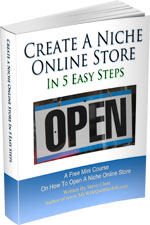
Ready To Get Serious About Starting An Online Business?
If you are really considering starting your own online business, then you have to check out my free mini course on How To Create A Niche Online Store In 5 Easy Steps.
In this 6 day mini course, I reveal the steps that my wife and I took to earn 100 thousand dollars in the span of just a year. Best of all, it's absolutely free!

